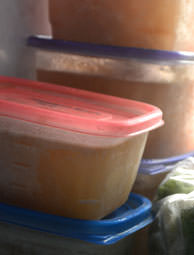
 Photo by Rachael Brugger Extend the life of your favorite soup or stew by freezing it in glass or plastic containers for up to six months. |

Whether you’re creating a back stock of broth, tomato and wild rice soup, corn chowder, chicken noodle soup or beef stew, proper food storage is critical for taste and safety. Soup stored at room temperature makes an ideal breeding ground for bacteria—an ingredient you don’t want to include in your soup recipe!
When your soup or stew has cooked and your guests have slurped their last spoonfuls, place your uncovered stockpot or saucepan in the sink and partially immerse it in ice water, stirring periodically to release the heat from the liquid. Allow the stockpot to cool to room temperature, but don’t leave it out, unrefrigerated, for longer than two hours. Once the soup or stew has cooled, it’s ready to be stored.
Refrigerator Storage
In the refrigerator, your stock, soup or stew will keep for three to four days. For quick and easy reheating, store single-serving portions in individual containers. For family-sized meals, store the soup in larger, resealable containers, and make sure to heat and chill the soup properly when serving and re-storing.
Freezer Storage
For a longer storage, you can freeze your favorite soup and stew recipes for up to six months. Simply transfer the soup to pint- or quart-sized containers (glass or plastic work just fine) or resealable freezer bags, and pop them in the freezer. Store them at 0 degrees F for top quality, advises Carolyn Raab, a food and nutrition specialist with the Oregon State University Extension Service.
“The more oxygen removed from the container, the better the food quality,” Raab says. “Remember, however, that removing the oxygen does not prevent bacteria from growing, so keep perishable foods cold when thawing.”
Canning Soups and Stews
If freezer space presents a challenge, consider canning your soups and stews. Canning is the process by which you ladle the soup or stew into pint or quart jars and process them in a high-temperature pressure canner. This slows the growth of dangerous bacteria, removes the air from the container and seals the soup in a safe, anaerobic environment that’s shelf-stable for up to one year. Because soups and stews contain low-acid ingredients, you must process them according to safe, proven canning recipes tested by food safety experts. If you don’t, you risk making yourself or others very sick.
Although you could whip together a clean-out-the-refrigerator soup to use up all your about-to-turn vegetables and meaty leftovers, the most delicious, nutritious soups and stews start with a rich stock, fresh and tasty ingredients and a time-tested recipe.
Excerpt from Soups & Stews, part of the Popular Kitchen Series, with permission from its publisher, BowTie, Inc. Purchase Soups & Stews here.




